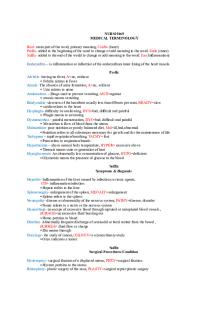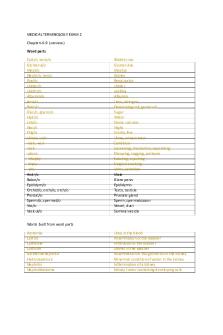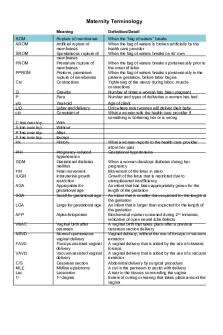Medical Terminology Lesson 9 - Copy PDF

| Title | Medical Terminology Lesson 9 - Copy |
|---|---|
| Author | jp deemi |
| Course | Biology |
| Institution | York University |
| Pages | 2 |
| File Size | 59.6 KB |
| File Type | |
| Total Downloads | 102 |
| Total Views | 144 |
Summary
Professor Ashen...
Description
Medical Terminology Lesson 9 Nervous System Combining form Cerebell/o Cerebr/o Encephal/o Medull/o Myel/o Neuro/o
Meaning Cerebellum Cerebrum Brain Medulla oblongata Spinal Cord nerve
PATHOLOGY Alzheimer disease – presenile dementia characterized by: -
Confusion Memory problems Disorientation Restlessness Speech disturbances Hallucinations Inability to carry out purposeful movements
Cerebrovascular accident (CVA) – a STROKE. Loss of blood supply to the brain tissue due to damage to the blood vessels of the cerebrum Coma – state of profound unconsciousness Concussion – a violent jarring or shaking or other blunt, nonprenetrating injury to the rbain caused by a sudden momentum change of the head. Typically although not always, a concussin is accompanied by a transient loss of consciousness Epilepsy – a brain disorder that causes recurring seizures Hemiplegia paralysis – paralysis affecting the right or left side of the body Meningitis - inflammation of the membranes surrounding the brain and spinal cord (meninges) Multiple sclerosis – characterized by the sclerotic plaque replacement of the myeline sheath on nerve cells in the central nervous system Paraplegia paralysis – paralysis affecting the lower portion of the body Shingles – Viral disease that affects the peripheral nerves and causes blisters on the skin of the affected nerve root Syncope – FAITNING. The sudden and temporary loss of consciousness resulting from inadequate blood flow to the brain DIAGNOSIS
Computed tomography (CT scan) – cross-sectional x-ray images of the brain and spinal cord Electoencephalography (EEG) - the recording of the electrical activity of the brain Lumbar puncture (LP) – provides a sample of cerebrospinal fluid (CSF) for analysis. It is a procedure in which the presence of CSF is measure and contrast may be injected for imaging (myelography) Magnetic resonance imaging (MRI) – radiofrequency and magnetic waves are used to create an image of the brain and spinal cord Myelography – imaging of the spinal cord after the injection of contrast Positron emission tomography (PET scan) – measurement of the uptake of radioactive material I the brain showing how the brain uses glucose and gives information about brain function
Assignment The Positron Emission Tomography (PET) scan is an imaging test that shows patterns of brain activity by measuring the uptake of radioactive material in the brain. It is based on the utilization of radioactive glucose or oxygen, which are the two primary nutrients needed to produce neural signals. The radioactive material gives off tiny positively charged particles and a camera records the positrons and turns the recording into pictures on a computer. PET scan is done to help detect cancer, heart disease, and brain disorders. It helps diagnose certain cancers, determine the stage of cancer, monitor treatment efficacy, and check for recurrence. PET scans can show areas of decreased blood flow in the heart, which can help doctors decide treatment plants. It can also be used to detect brain disorders like tumors, Alzheimer’s disease and seizures.
What diagnosis might the doctor be looking for? Which part of the body is being studied...
Similar Free PDFs

Medical Terminology- Lesson 6-11
- 13 Pages

Medical Terminology
- 50 Pages

Medical Terminology
- 6 Pages

Medical Terminology
- 2 Pages

Medical Terminology
- 4 Pages

Medical Terminology EXAM 2
- 4 Pages

Medical terminology Modules
- 158 Pages
Popular Institutions
- Tinajero National High School - Annex
- Politeknik Caltex Riau
- Yokohama City University
- SGT University
- University of Al-Qadisiyah
- Divine Word College of Vigan
- Techniek College Rotterdam
- Universidade de Santiago
- Universiti Teknologi MARA Cawangan Johor Kampus Pasir Gudang
- Poltekkes Kemenkes Yogyakarta
- Baguio City National High School
- Colegio san marcos
- preparatoria uno
- Centro de Bachillerato Tecnológico Industrial y de Servicios No. 107
- Dalian Maritime University
- Quang Trung Secondary School
- Colegio Tecnológico en Informática
- Corporación Regional de Educación Superior
- Grupo CEDVA
- Dar Al Uloom University
- Centro de Estudios Preuniversitarios de la Universidad Nacional de Ingeniería
- 上智大学
- Aakash International School, Nuna Majara
- San Felipe Neri Catholic School
- Kang Chiao International School - New Taipei City
- Misamis Occidental National High School
- Institución Educativa Escuela Normal Juan Ladrilleros
- Kolehiyo ng Pantukan
- Batanes State College
- Instituto Continental
- Sekolah Menengah Kejuruan Kesehatan Kaltara (Tarakan)
- Colegio de La Inmaculada Concepcion - Cebu








